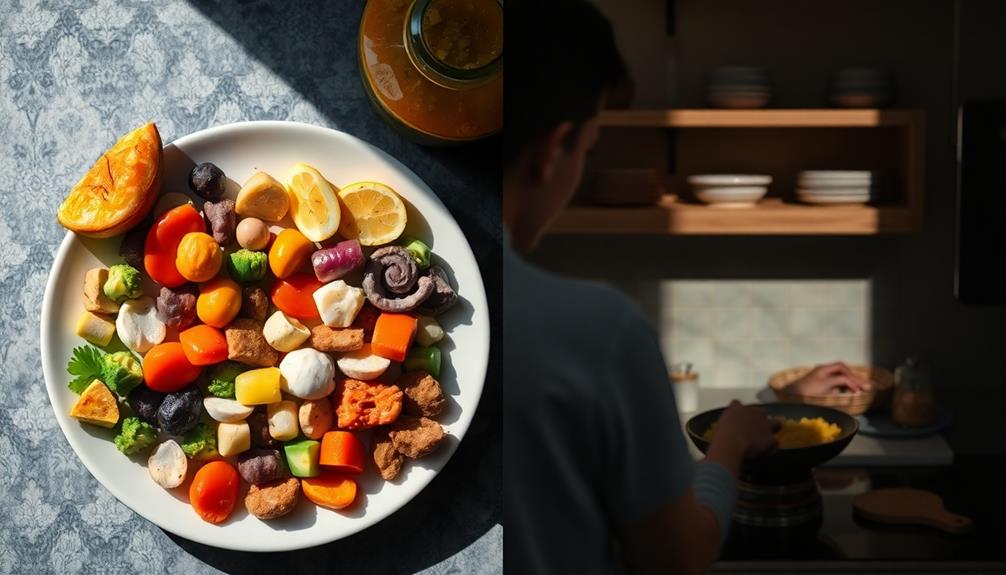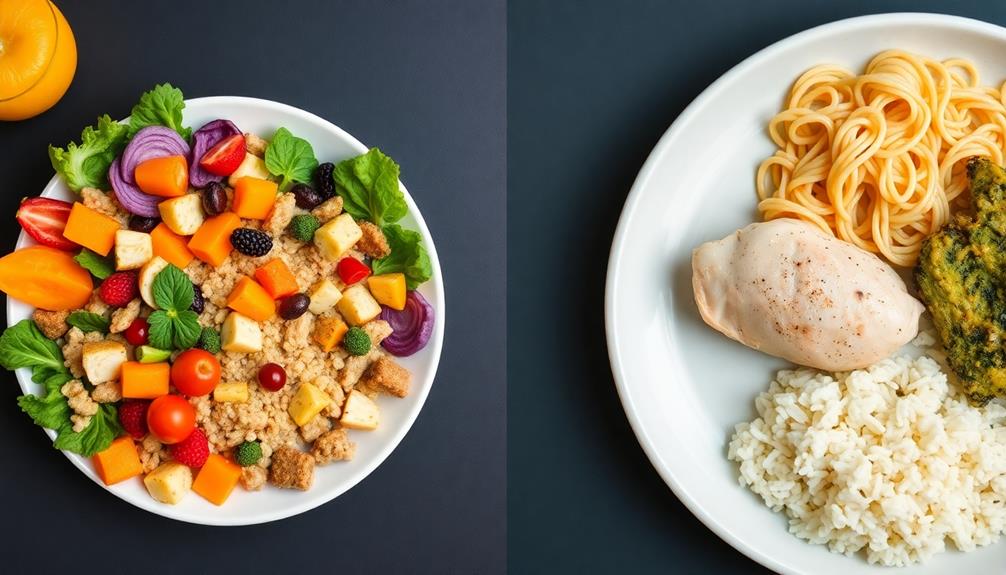You can develop selective eating habits as an adult due to a combination of genetic, psychological, and environmental factors. Sensory sensitivities may cause you to avoid certain tastes and textures, while previous negative food experiences can result in food neophobia – a fear of trying new foods. Family influences and a lack of exposure to diverse cuisines during childhood can also impact your eating preferences. Anxiety about food choices can add an extra layer of complexity, especially in social settings. It’s important to recognize these factors and their influence in order to enhance your relationship with food. There is more to discover about how to make positive changes.
Key Takeaways
- Genetic predispositions, such as variations in taste receptor genes, can heighten sensitivity to certain flavors, contributing to picky eating in adulthood.
- Past negative food experiences create psychological barriers, making adults reluctant to try new foods and reinforcing selective eating habits.
- Sensory sensitivity to textures and tastes often leads to strong aversions, influencing food choices throughout adulthood.
- Limited exposure to diverse cuisines in childhood can hinder flavor appreciation, resulting in persistent picky eating behaviors into adulthood.
- Social anxiety during meals can exacerbate picky eating tendencies, as adults may feel pressured to conform to eating norms.
Understanding Picky Eating

Picky eating often stems from a complex mix of genetic, psychological, and environmental factors. You might find that your selective food preferences persist from childhood into adulthood, often driven by food neophobia—the fear of trying new foods. This aversion can be tied to psychological factors, like anxiety or negative experiences with certain dishes, making you more cautious about what you eat.
Additionally, exposure to diverse cuisines, such as the rich flavors found in Brazilian cuisine, can help expand your palate and encourage exploration of new dishes.
Your sensory sensitivity also plays a significant role. If you're particularly sensitive to certain textures or tastes, you're likely to avoid foods that feel slippery or taste bitter, leading to a restricted diet.
Environmental influences, such as the eating habits of your family or cultural norms, shape these preferences as well. If you grew up in a household that favored specific comfort foods, you may have developed a lasting attachment to those familiar flavors.
Understanding these various influences is essential. Recognizing how they intertwine can help you make sense of your picky eating tendencies and encourage you to explore new food options at your own pace.
Embracing gradual changes can lead to a more varied and enjoyable eating experience in the long run.
Genetic and Environmental Factors

Understanding the genetic and environmental factors influencing your food preferences can illuminate why you might hesitate to try new dishes. Picky eaters often have genetic predispositions, including variations in taste receptor genes that lead to food neophobia—the fear of trying unfamiliar foods. This can heighten sensitivity to bitter flavors and make certain textures off-putting.
For instance, individuals who've been exposed to a narrow range of flavors may find it particularly challenging to appreciate diverse cuisines, such as the rich blend of spices found in Mushroom Masala. Your family upbringing plays an essential role in shaping your eating habits. Early exposure to a variety of foods can enhance your willingness to experiment with new flavors.
Additionally, various environmental factors contribute to your choices:
- Accessibility to diverse food options
- Cultural norms surrounding food
- Societal expectations about what's considered acceptable
- Peer influences on dining experiences
These elements collectively determine the food landscape you navigate as an adult. If your environment lacks variety or encourages limited choices, it can reinforce picky eating behaviors.
Understanding these influences helps you appreciate why certain foods might feel intimidating and why broadening your palate might be a challenge. Recognizing these factors is the first step towards overcoming food aversions and embracing new culinary experiences.
Psychological Aspects of Picky Eating

When it comes to your food choices, anxiety can play a significant role in what you're willing to eat.
If you find yourself feeling overwhelmed by certain textures or smells, sensory processing differences might be at play.
For instance, dishes such as Muamba De Galinha from Angola, with their rich flavors and textures, could be particularly challenging for someone with picky eating tendencies.
Understanding these psychological aspects can help you address your picky eating habits more effectively.
Anxiety and Food Choices
Eating can be a source of anxiety for many adults, particularly for those who struggle with selective food preferences. If you identify as a picky eater, you might find that your food choices often trigger feelings of psychological distress and social anxiety during meals. This can lead to embarrassment and avoidance of social eating situations.
Research shows that picky eaters tend to score higher on anxiety measures compared to their non-picky peers, which highlights a significant connection between anxiety and selective eating. Certain foods, such as those with complex textures or unfamiliar flavors, may intensify this anxiety, making it essential to understand personal food preferences. Exploring traditional dishes, like Dorayaki (Red Bean Pancake), might provide a comforting way to ease into new tastes without overwhelming oneself.
Consider these factors that might contribute to your anxiety around food:
- Heightened sensitivity to tastes, smells, and textures.
- Past negative food experiences that create psychological barriers.
- A desire to assert control in overwhelming social settings.
- Food neophobia, or the fear of trying new foods.
These elements can create a cycle where anxiety perpetuates picky eating behaviors. Understanding these connections can help you navigate your food choices with greater awareness, making it easier to tackle the underlying anxiety that often accompanies picky eating.
Sensory Processing Differences
Many adults who struggle with picky eating also experience sensory processing differences that amplify their food preferences. These differences often result in heightened sensitivity to tastes, smells, and textures, making certain foods, especially those with strong flavors or unusual textures, more likely to be rejected.
For instance, if you've got texture sensitivity, you might avoid slippery foods like eggs or gelatinous items, finding them unpalatable. In Ethiopian cuisine, dishes like Yekolo (Roasted Barley) offer unique textures that might be challenging for those with such sensitivities.
Additionally, picky eaters often have a strong aversion to bitter and sour flavors, which can stem from genetic variations affecting taste receptor genes. This aversion can lead to food neophobia, a fear of trying new foods, often fueled by past negative experiences, like choking or allergic reactions.
When confronted with unfamiliar dishes, you might feel anxious or emotionally distressed, reinforcing selective eating behaviors.
Developmental Influences

Your eating habits today may be shaped by a mix of genetic factors, childhood experiences, and cultural influences.
For instance, exposure to diverse flavors and textures, such as those found in dishes like Red-Braised Pork Belly, can play a significant role in developing a more varied palate.
If you grew up with a limited variety of foods or faced sensory sensitivities, it's likely those patterns have followed you into adulthood.
Understanding these developmental influences can help you navigate your picky eating tendencies more effectively.
Genetic Factors Impacting Preferences
Picky eating often stems from a complex interplay of genetic factors that considerably shape our food preferences. Your genetic predisposition can considerably influence how you perceive and enjoy different flavors.
Research shows that variations in taste receptor genes are linked to taste sensitivity, especially regarding bitter flavors, which can lead to food neophobia—the fear of trying new foods. This genetic basis can affect both children and adults. For instance, those who are sensitive to certain tastes may find it challenging to enjoy traditional dishes like Kue Putu (Bamboo Rice Cake) or Dadar Gulung (Pandan Crepe), which offer unique flavor profiles that might be off-putting.
Consider these key aspects of how genetics impact your food preferences:
- Taste Sensitivity: Your sensitivity to certain tastes, particularly bitterness, can drive you away from certain foods.
- Food Neophobia: Genetic factors may instill a reluctance to try unfamiliar foods, making you hesitant in social dining situations.
- Sensory Processing: Heightened sensitivity to tastes and textures can make certain foods unpalatable.
- Heritability: The heritability of appetitive traits suggests that picky eating can persist throughout life, influencing your dietary choices as an adult.
Understanding these genetic influences can help you navigate your picky eating tendencies and potentially expand your palate.
Childhood Experiences and Habits
Childhood experiences play a significant role in shaping your eating habits as an adult. Many adults with picky eating habits started as picky children, indicating that early food preferences often carry over into adulthood.
If you were exposed to a variety of foods during your childhood, you're more likely to develop a willingness to try new dishes later on. For instance, being introduced to diverse ingredients like heirloom beans or fresh herbs could expand your palate. Conversely, a limited food environment can solidify restrictive eating patterns.
Family influence is essential in this development. Children often mirror the eating behaviors of their family members, which can reinforce picky eating habits. If your family favored certain foods or avoided others, those preferences likely became your own.
Additionally, sensitivity to the texture of food plays a key role in your eating habits. For instance, if you'd an aversion to gelatinous or slippery foods as a child, it's possible that this sensitivity continued into adulthood, narrowing your food choices.
Lastly, the evolutionary caution against unfamiliar foods might still impact your food preferences today. This instinctive behavior served as a survival mechanism, ensuring that you approached new foods with caution.
Understanding these childhood experiences can help you address and possibly reshape your picky eating habits.
Environmental and Cultural Influences
How do environmental and cultural influences shape your eating habits? Your cultural background plays a significant role in determining what foods you find acceptable or appealing. The societal norms you grow up with affect your willingness to try new dishes.
For example, traditional dishes like Vegetable Salad might shape your view on fresh produce and healthy eating. Early exposure to various foods during childhood sets the stage for your future preferences, as positive experiences with diverse flavors can lead to greater openness later on.
Consider these factors that contribute to your eating habits:
- Cultural background: Shapes your perceptions of what's considered normal or desirable in food.
- Early exposure: A diverse diet in childhood can foster a more adventurous palate as an adult.
- Family eating habits: You often mirror the food choices of your parents or caregivers, which can reinforce picky eating patterns.
- Media representation: Advertising and portrayals of food can influence your aversions and preferences, aligning them with cultural ideals.
Social Anxiety and Eating

At social gatherings, the pressure to fit in can make eating a particularly stressful experience for those who are picky eaters. The presence of social anxiety can heighten your discomfort, leaving you feeling embarrassed about your food choices.
In environments like cocktail parties or business lunches, you might find yourself overwhelmed by the anxiety surrounding meals, which could even lead you to avoid these situations altogether. For example, bringing along familiar snacks or dishes, like a festive Graveyard Taco Dip, can ease your tension and spark conversations around food.
Many picky eaters, like you, often carry preferred snacks to social events. This reliance on familiar foods helps mitigate anxiety and provides a sense of security. Studies reveal that picky eaters report higher levels of social eating anxiety, resulting in enjoyment impairment during meals.
As you navigate social situations, the pressure to conform to eating norms can exacerbate your anxiety, making you reluctant to try new foods in group settings.
In these moments, it's common to feel the weight of judgment from others, increasing your distress. Understanding how social anxiety intertwines with picky eating can help you find strategies to cope, making social gatherings a bit more manageable and enjoyable.
Characteristics of Picky Eaters

Many picky eaters share distinct characteristics that shape their dining experiences and preferences. Understanding these traits can help you relate to or identify with the challenges they face. Here are some common characteristics of picky eaters:
- Strong aversion to bitter and sour foods: Many reject vegetables and mixed dishes due to these flavors.
- Preference for familiar comfort foods: You might find that fries and grilled cheese are staples in your diet, overshadowing more diverse culinary options.
- Texture sensitivity: If you avoid slippery textures, like those in eggs or gelatinous foods, you're not alone. This sensitivity plays a significant role in your food choices.
- Anxiety during social meals: Feeling embarrassed about your food preferences can lead you to avoid certain social settings.
These traits can contribute to avoidant/restrictive food intake disorder and result in limited food intake.
Picky eaters often report less enjoyment of eating overall and may view themselves as unhealthy due to their limited dietary variety.
Acknowledging these characteristics is the first step in understanding picky eating in adulthood.
Strategies for Change

Transforming your eating habits can feel intimidating, but with the right strategies, you can gradually expand your palate. Here are some effective approaches to help you on this journey:
| Strategy | Description | Benefits |
|---|---|---|
| Gradual Exposure | Introduce one new food alongside your favorites. | Reduces anxiety over new foods. |
| Positive Reinforcement | Reward yourself for trying new foods. | Encourages experimentation. |
| Modify Cooking Methods | Try roasting or grilling to enhance flavors. | Makes new foods more appealing. |
| Non-Threatening Environment | Share cooking experiences with supportive individuals. | Improves mealtime experiences. |
| Coping Strategies | Use tips from professionals to deal with aversions. | Expands dietary variety. |
Seeking Professional Support

Seeking professional support can be a game changer for adults dealing with picky eating. By consulting with experts, you can gain valuable insights and tailored strategies to help you navigate your food preferences.
Here's how professional support can make a difference:
- Nutritionists can provide personalized advice for gradually introducing new foods into your diet.
- Occupational therapy can assist in overcoming sensory challenges, such as texture aversions or gag reflexes, making it easier to try new things.
- Supportive therapy can help you address the emotional aspects of picky eating, including managing anxiety related to your food choices.
- Specialists can guide you in using systematic desensitization, a therapeutic approach that gradually introduces new foods, allowing you to expand your palate comfortably.
Tracking your progress and setting small, achievable goals with the help of professionals can also motivate you to improve your relationship with food.
Embracing this support can lead to a more varied diet and greater enjoyment of meals, ultimately enhancing your overall well-being.
Don't hesitate to reach out—your journey toward a more adventurous eating experience can start today!
Recognizing Serious Concerns

Recognizing the signs of serious concerns related to picky eating is vital for your health. If you identify as a picky eater, it's important to be aware that extreme cases may indicate Avoidant Restrictive Food Intake Disorder (ARFID). This mental health condition often leads to significant weight loss and nutritional deficiencies, putting your overall well-being at risk.
If you find yourself feeling distressed about food choices or experience anxiety or depression tied to your eating habits, these psychological issues could be warning signs. Research shows that adult picky eaters report higher levels of eating-related clinical impairment compared to moderate eaters. This can lead to long-term consequences, such as heart and bone problems due to inadequate nutrient intake.
Take a moment to evaluate your eating behaviors. Are you avoiding entire food groups? Have you noticed significant weight loss? If so, it might be time to seek professional help.
Awareness of these potential health concerns can make a difference in your journey toward better eating habits and improved mental health. Don't hesitate to reach out if you're struggling; recognizing these serious concerns is the first step toward recovery.
Frequently Asked Questions
What Is the Root Cause of Picky Eating?
Picky eating often roots in genetic factors, sensory sensitivities, and past experiences. You might also find your preferences shaped by family and cultural influences, which can create lasting habits that persist into adulthood.
What Is the Psychology Behind Picky Eaters?
The psychology behind picky eaters often involves heightened sensory sensitivities, anxiety about new foods, and negative past experiences. These factors create strong food preferences, making it challenging for you to try unfamiliar dishes.
Why Did I Suddenly Become a Picky Eater?
You might feel like you've suddenly entered a food war zone! Changes in taste, heightened anxiety, or past experiences could be triggering your pickiness. Reflect on your recent emotional and environmental shifts for deeper insights.
How Do You Treat an Adult Picky Eater?
To treat an adult picky eater, gradually introduce new foods alongside familiar ones. Use positive reinforcement, create a relaxed mealtime atmosphere, and consider professional guidance to address any underlying anxieties or texture sensitivities.
Conclusion
In understanding picky eating, it's clear that a mix of genetics, environment, and psychology plays a role. If you find yourself avoiding certain foods, like Sarah, who struggles to eat vegetables due to a childhood aversion, know you're not alone. By exploring strategies for change and possibly seeking professional support, you can expand your palate and improve your relationship with food. Remember, it's never too late to embrace new flavors and experiences!








